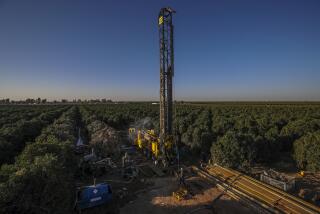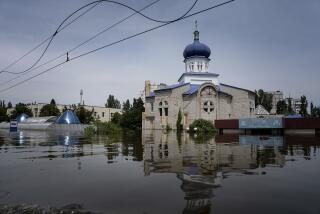6 Arab Nations on Persian Gulf Fear Depletion of Ground Sources of Fresh Water
- Share via
MANAMA, Bahrain — Oil remains in good supply, but fresh water is running low in the six Arab nations on the Persian Gulf. United Nations experts are concerned.
The Dammam aquifer, running like an umbilical cord under the six nations, provides an estimated one-third of their overall water. But with all six states sucking up the water faster than nature can put it back, the experts predict a future far more arid than it is now.
“Man can live without food for two to three months, but he would die without water (in) two to three days,” said Ahmed Adel Orabi, deputy director of the regional U.N. Environmental Program, which is based in Bahrain, a Gulf island.
“If extraction continues to exceed recharge, the Dammam aquifer can dry up within 10 to 50 years,” he said. “If well-exploited, it can last forever.”
Water resources are a problem throughout the Middle East: Riots broke out in Sudan in July over fluctuations in the water supply; Libya is expecting to invest $25 billion in an underground river system; some analysts see a danger of wars in the future over the area’s water resources.
The Dammam aquifer stretches the length of the western coastline of the Persian Gulf, from Kuwait in the north through Saudi Arabia, Bahrain, Qatar, the United Arab Emirates and Oman.
The reservoir, used mostly for agriculture, is the source of the artesian wells that allowed oases to flourish along the coast for hundreds of years.
But oil wealth brought new demands on the water supply as economies expanded.
Saudi Arabia has a daily desalinated water flow of 588 million gallons for a population of less than 12 million. With its vast oil reserves, it can afford it.
But states like Bahrain still have to rely on nature, and officials here view the depletion of the Dammam aquifer with alarm. Bahrain gets 50% of its water from the underground system.
“Water has been stored in the reservoir over millions of years. . . . Over the past 10 to 15 years, it is being bled more than can be compensated,” said Jamil Al-Alawi, Bahrain’s assistant undersecretary for power and water affairs.
Bahrain’s finances, battered by soft oil prices, have enabled it to build only two desalination plants. A third, a gift from Saudi Arabia, has been delayed.
Desalination plants make it unlikely that anyone in the area will go thirsty. But the cost of the refined water is prohibitive for farm irrigation. This means that water from the aquifer could be the key to agricultural and economic development.
“Desalination plants complement the reservoir, they are good for drinking purposes, but it is the reservoir that helps (keep) vital development going,” said Orabi. “There can be no food security without water security.”
Area leaders call for nationwide prayers when the rains do not come in the winter, while newspaper and television campaigns skewer careless users.
Television programs remind Bahrainis that only 50 years ago water used to be hauled in from the kawkabs --the sweet-water springs.
“Water is our most precious source of life. When it’s gone, so are we,” said another TV program.
This year’s rains have been bountiful, so much so that tomato growers on Bahrain nearly lost their crops.
But rains are unpredictable.
The U.N. Environmental Program hopes to come up with a comprehensive plan within two years for conserving the Damman aquifer, and an international agreement might have to be worked out to distribute the water among the six nations.
More to Read
Sign up for Essential California
The most important California stories and recommendations in your inbox every morning.
You may occasionally receive promotional content from the Los Angeles Times.









